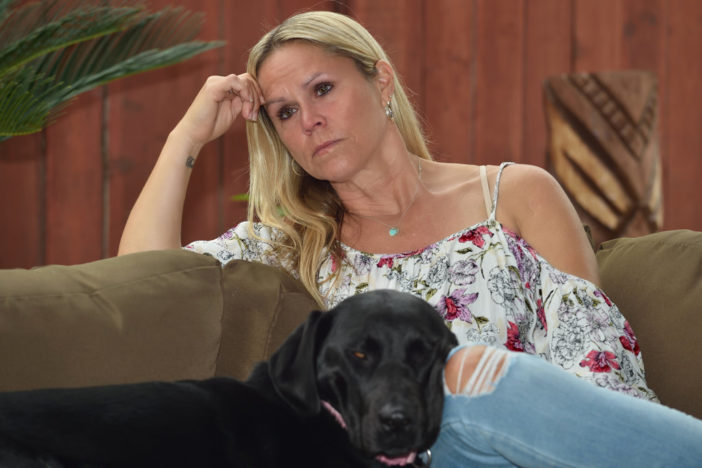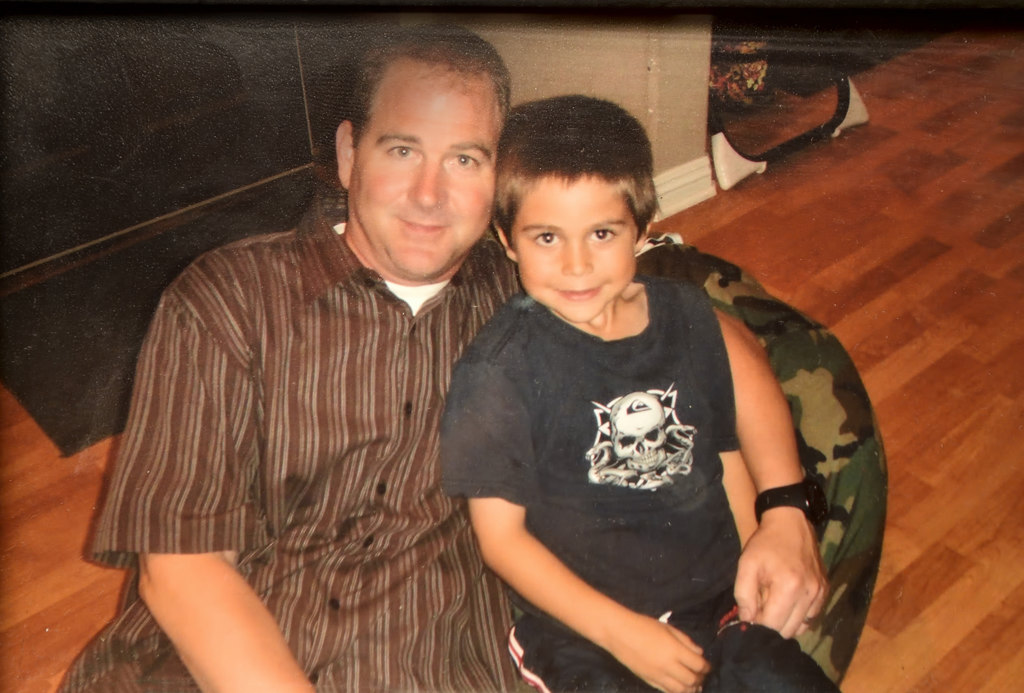Editor’s note: As part of our 10th anniversary, Behind the Badge is sharing stories from our archives: This story is from 2019.
The two cops sat down for coffee.
It was a Friday, Cord Vandergrift’s day off.
He knew his good buddy and Westminster PD colleague Tom Richard was spontaneous, so Tom asking Cord to meet him for coffee at Lee’s Sandwiches, near the WPD station, wasn’t out of the ordinary.
It was late morning on Friday, Feb. 15, 2013.
Cord and Tom spent about 20 minutes chatting.
Still raw on their minds was the suicide, less than a year before, of their WPD colleague, Officer Ken Pate.
Pate, a tenacious officer with a knack for locating parolees, drugs addicts, and stolen cars, killed himself in his Laguna Niguel garage on April 28, 2012. Forty-eight, he left behind a wife and two kids.
Cord looked at Tom, his close friend of more than 15 years — and the officer who trained him when Cord started at the WPD in 1996 — and asked Tom something he’d asked him countless times before:
“How could he do that? How could he leave behind his family and his kids? That’s the most selfish thing anyone could ever do.”
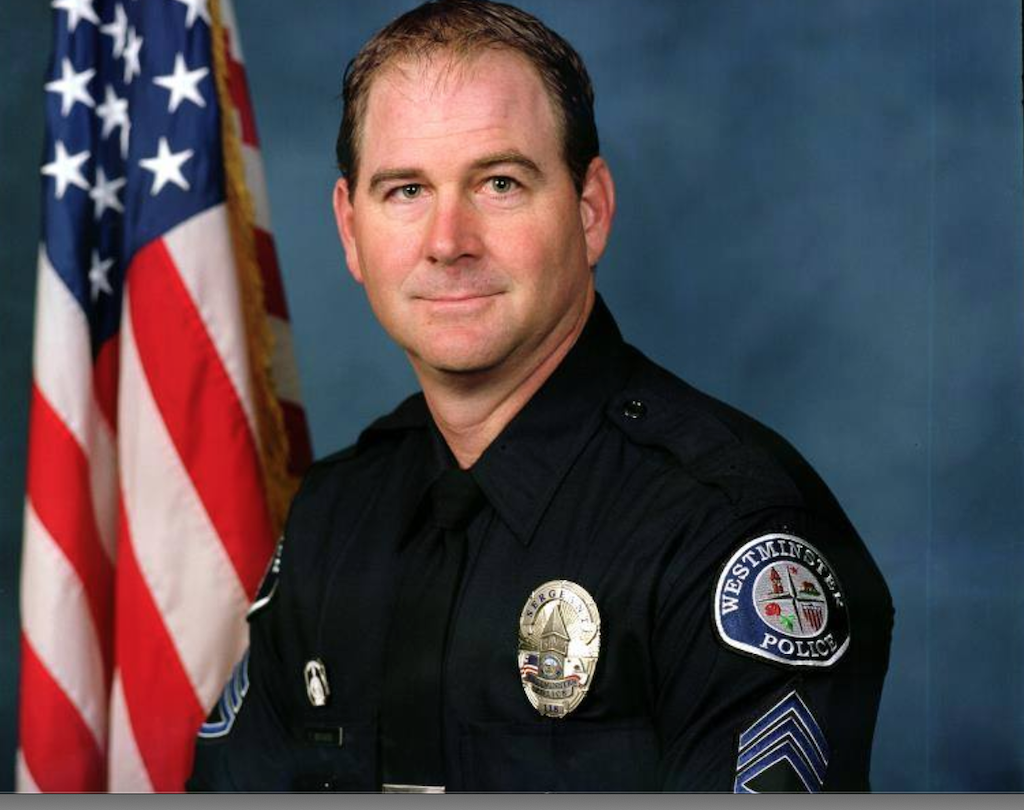
Tom Richard was a pioneer in peer support at the Westminster PD. He helped start the WPD’s Trauma Support Team, which became a model for other law enforcement agencies. Photo courtesy of Westminster PD
“Cord, you have to understand,” Tom replied. “Sometimes you get to the point where there’s just no way out, and the only way out is to end your life. I can’t explain it to you, but that’s what it is. Don’t take it personally. Don’t think that person’s being selfish. That’s the only way they know how to get the pain to stop.”
Tom asked Cord if he could go golfing with him the next day, Saturday, Feb. 16.
“Sorry man, I have plans.”
“It was just a normal conversation,” recalled Cord, now a commander at the WPD.
Sometime on the night of Feb. 16, 2013 – the day after Tom and Cord had coffee — Tom killed himself with a single gunshot wound to his head.
When he was found the next morning, his badge was in his left hand.
THE TOLL
Suicide claims more officers’ lives annually than violence in the line of duty, a trend that has been constant over the last several years.
As of Aug. 22, 2019, there have been at least 127 law enforcement suicides in the United States this year, according to Blue HELP, a Massachusetts nonprofit. That number includes retired officers. There were at least 167 officer suicides last year, according to Blue HELP.
“We’re on pace this year to go well over the number of suicides we had last year,” said Karen Solomon, president and co-founder of Blue HELP.
Solomon said the actual number of suicides likely is higher because her nonprofit relies on colleagues, loved ones, and friends of fallen officers to self-report.
The goal of Blue HELP is to put a face on each police suicide and to get the public to talk about it more, in the hopes of encouraging officers struggling with depression or mental illness to seek the help they need – and not be ashamed about it.
“We should be talking about this like we talk about anything else,” said Solomon, frustrated that suicide and mental illness – especially in law enforcement – still comes with a stigma, although that has eased somewhat in recent years.
Still, Solomon and other experts agree society has a long way to go.
Tom’s suicide, WPD officials and others say, could make a big difference.
In what would be a first, current and retired WPD officers are working on getting Tom’s name put on a peace officers memorial not only in Westminster, but on the California Peace Officers’ Memorial, and after that, the National Law Enforcement Officers Memorial.
It’s an audacious challenge. The National Law Enforcement Officers Memorial Fund does not currently recognize suicide as a line-of-duty death, nor does the state memorial.
But the WPD views Tom’s suicide as a line-of-duty death.
“There’s no doubt in anyone’s mind that Tom’s suicide was caused by a work-related incident,” Cord says. “To me, it’s the same as him getting shot and killed (by a suspect).”
Bill Collins, who retired from the WPD last year as deputy chief after a 29-year career, and who is a former roommate of Tom’s, agrees.
“Tom’s suicide had a clear-cut nexus to his job,” Collins says.
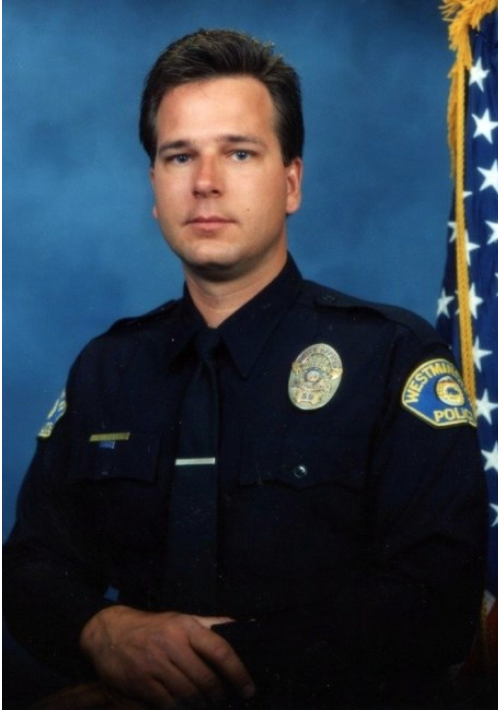
WPD Officer Ken Pate killed himself less than a year before Tom Richard’s suicide. Ken’s suicide weighed heavily on Tom. Photo courtesy of Westminster PD
THE ACCIDENT
Tom Richard was a fresh-faced WPD rookie of 21, with only eight months of patrol experience, when his life forever changed on Christmas morning 1988.
“I absolutely loved my job as a police officer and could not wait to get to work each day…I was probably the only one on duty who wanted to be at work (that day),” Tom wrote years later, in a doctoral dissertation.
After he medically retired from the WPD in 2012 due to a back injury after 25 years of service, Tom went on to earn a doctorate degree in psychology from the University of Chicago.
But on Dec. 25, 1988, Tom was writing reports in his patrol car at a park on the east side of Westminster when the call went out around 9 a.m.:
Additional officers were needed at a family disturbance. A fight had broken out.
Then came a Code 3 backup request. All available WPD officers began rolling to the house, sirens blaring and lights flashing.
Tom knew he had to get to the scene on the other side of town as quickly as possible.
As he approached the intersection of Newland Street and Westminster Boulevard, Tom spotted another officer ahead of him.
Not having had time to look up the address of the house, Tom knew the cop ahead of him – his shift sergeant — would lead him to it.
As Tom approached the intersection, he saw the light change to yellow.
He wasn’t aware of it at the time, but he was traveling at 84 mph.
When he went through the intersection, he saw a car pull out in front of him.
Then everything turned white, Tom later would recall.
He felt the impact of his patrol car slamming into the driver’s side of the car and then his patrol car spinning, seemingly in slow motion, to the sickening sound of metal on metal.
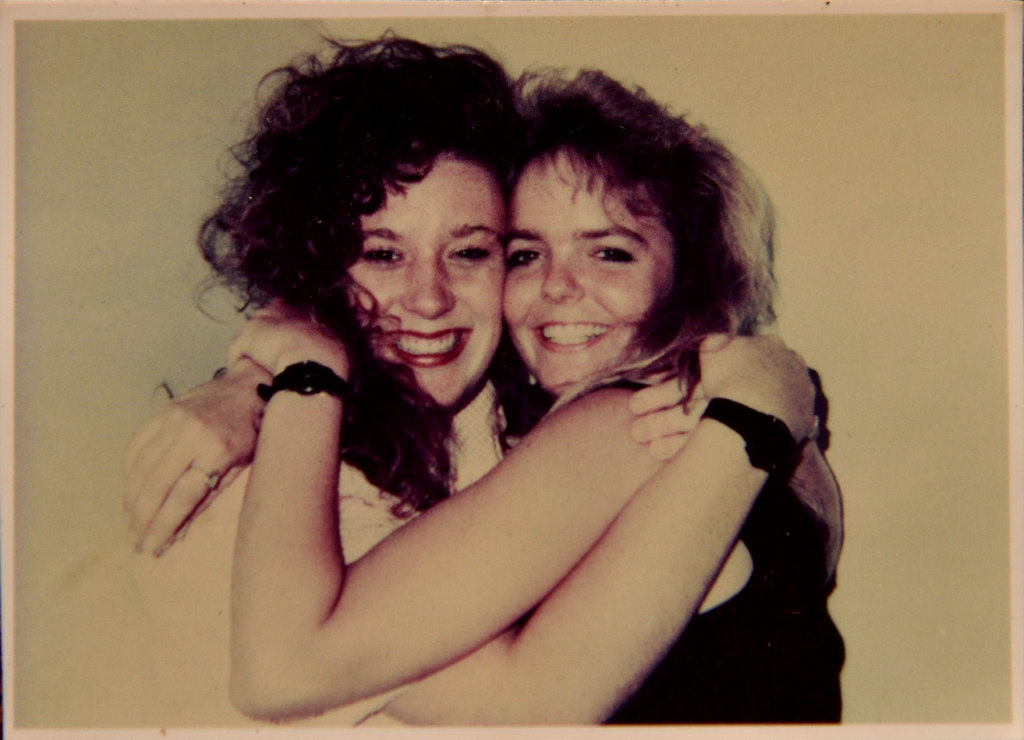
Jessica Warren (left) and Dawn Hammond were best friends who met at La Quinta High School in Westminster. Jessica, 19, and Dawn, 20, were attending Golden West College when they were killed on Christmas morning 1988. Dawn was interested in a career in law enforcement. Photo courtesy of Janet Hammond
THE VICTIMS
Dawn Hammond, with blonde ’80s rock goddess hair and blue eyes that would beam when she broke out into her near-constant smile, always wanted to live by the beach.
Her dream came true in July 1988, when she and her mother, following a divorce, moved into a three-bedroom condo in Costa Mesa, just across the Santa Ana River that divides Costa Mesa and Huntington Beach.
It was a 15-minute bike ride to the ocean.
Dawn, whose family relocated from Vancouver to Orange County when she was a young girl, spent a lot of time that summer biking to the beach and hanging out with her best friend, Jessica Warren, who lived in Stanton.
Dawn was the more talkative and outgoing of the two. The best friends met at La Quinta High School in Westminster. They both were children of divorced parents. When Dawn was 14, she and Jessica went to England, where Dawn’s parents are from.
They were decent students and popular with the boys, and were just starting to figure out what they wanted to do with their lives after graduating from high school that spring.
Dawn started criminal justice classes in fall 1988 at Golden West College. She was thinking about a career in law enforcement. Jessica also went to GWC, and was interested in a career in media and communications.
Dawn’s coworkers at Silky Sullivan’s Restaurant & Irish Pub called her “Dawn of the Dog.” On Tuesdays, she would hand out hot dogs at the Fountain Valley establishment.
On Dec. 5, 1988, Dawn turned 20.
Jessica, 19, was driving her Honda Accord that Christmas morning. She and Dawn were heading to the Santa Ana home of one of Dawn’s brothers to open presents.
That year, Jessica spent a lot of time at Dawn’s condo in Costa Mesa – maybe even more than at her own home, recalls Janet Hammond, Dawn’s mother.
Dawn and Jessica had a habit of hopping into Janet’s bed to talk to her about life and boys.
“She was bubbly, friendly,” Janet recalls of her only daughter. Janet and her ex-husband, Ken, had two older sons.
“She could talk the hind legs off a cow,” Janet says of Dawn. “She was just a friendly young woman.”
When Jessica drove through the intersection of Newland Street and Westminster Boulevard at around 9 a.m. Christmas morning 1988, with Dawn sitting in the passenger seat, Janet Hammond was 5,360 miles away in Coventry, England.
She had decided, for the first time in years, to spend Christmas with her parents.
THE AFTERMATH
The patrol car of dazed Officer Tom Richard came to a rest. The inside started filling up with smoke. His door opened suddenly, and a person pulled him from the car.
Although injured, Tom was able to walk on his own.
He tried to radio dispatch, but his radio wasn’t working.
Tom later would recall feeling alone, scared, and helpless.
He realized he had T-boned another car and looked around for it.
Jessica’s car had come to rest in front of a planter at a gas station.
Several witnesses were speaking to Tom, but he didn’t hear them.
When he got to the mangled Honda Accord, Tom ordered several people hovering around it to move away.
As he stepped closer, he saw a female – Jessica Warren — slumped over the steering wheel.
She was motionless and unresponsive.
Tom grabbed one of her wrists to locate a pulse.
“For a moment,” Tom wrote years later, “I thought I felt one, but I then lost it. It was then I realized she was dead. I was overwhelmed with fear, shock, loneliness, hopelessness, and bewilderment of what had happened.”
Tom started to walk to WPD police headquarters to get help.
He heard sirens in the area, so he remained at the scene. He soon found out another female in the car — Dawn Hammond — had died.
Jessica and Dawn were killed instantly.
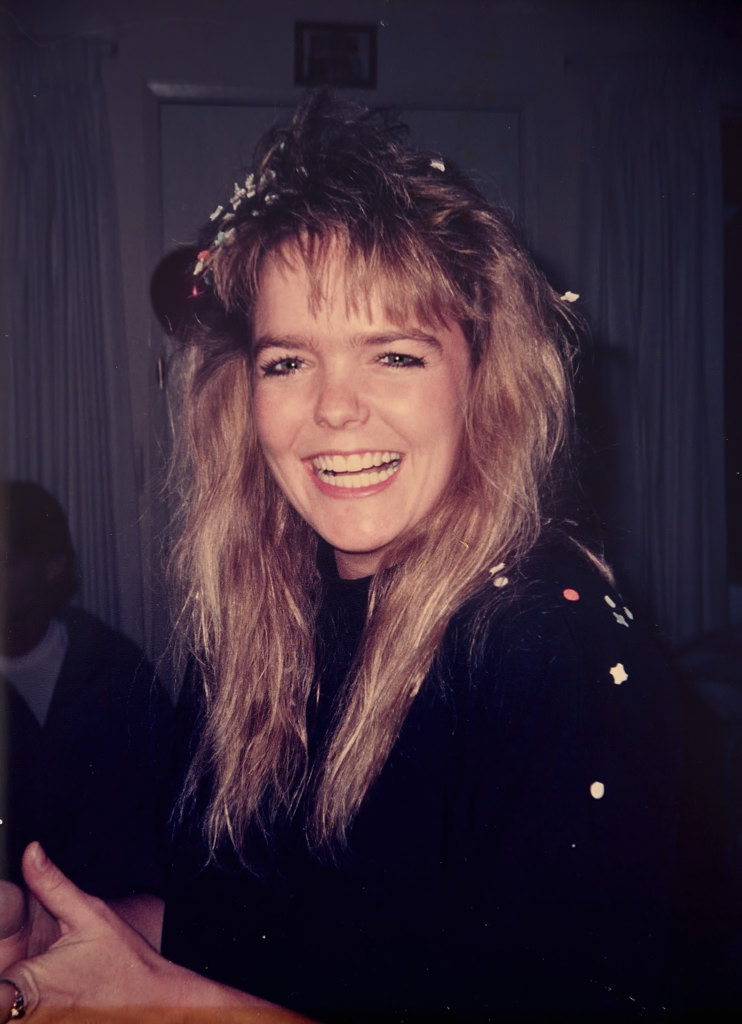
Dawn Hammond celebrates her 20th birthday less than three weeks before she was killed. Photo courtesy of Janet Hammond
On Nov. 22, 1989 – less than a year after the double-fatality — a jury in Westminster acquitted Officer Tom Richard of vehicular manslaughter, determining that he was not negligent when he sped through the intersection.
In the courtroom gallery, Janet Hammond, sitting next to her ex-husband as the verdict was read, burst into tears.
THE MISSION
Back when Dawn and Jessica were killed, not a lot was being done in law enforcement to assist traumatized officers.
Tom, who went to Foothill High School in Tustin and whose father is a retired officer from the Orange PD, became instrumental in helping to change that.
In addition to his regular police work, which included stints on the narcotics and SWAT units, Tom devoted his career at the WPD to helping fellow officers get over traumatic calls as well as problems in their personal lives.
In 1996, he helped start the Westminster PD’s Trauma Support Team, which became a model for other law enforcement agencies. Led by a licensed psychiatrist, the Trauma Support Team was established to assist other officers who had experienced severe trauma – just like Tom had.
“It was a new idea in law enforcement at the time,” recalls Dan Schoonmaker, who started at the WPD two years after Tom. “We were on the leading edge of it. I think Tom did it out of his desire to not only to help other people, but to find answers for himself.”
Dan and Tom became close working together on the SWAT and narcotics details.
“We were both attracted to the same type of police work,” Dan says, “so we had a great friendship come out of all that.”
Tom was known around the WPD as a hard-working cop who wasn’t the loudest person in the room, but who had a strong presence.
“His personality was very magnetic,” says Dan, who rose to the rank of deputy chief at the WPD before leaving in 2016 to become police chief of Poulso, a town of around 3,000 on Liberty Bay in Washington.
“People were just drawn to him,” Dan says. “He was probably the best listener and the deepest thinker. When you asked him to help work through problems, he always had solutions. He never was super-opinionated about things. Tom was just a guy who helped you see both sides of everything. He was thoughtful.”
In the field, Tom was skilled at communicating with people.
He also was known as having a warrior spirit – a cop who wasn’t afraid to get into dangerous situations.
He would rise up to them every time, but never in a reckless way, colleagues say.
THE MARRIAGE
Tom had two young sons from a first marriage when he met Officer Carrie Clark at the WPD.
Tom and Carrie started off as friends but eventually hit it off romantically after Tom divorced his wife in 1997.
Carrie and Tom married in May 1999.
After tearing a tendon in a wrist during a fight with a suspect, Carrie retired from the WPD in 2003 after eight years of service.
Carrie and Tom had a son, Logan, and they adopted a girl from Russia, Galina.
Throughout their 14-year marriage, they enjoyed annual trips to Cabo San Lucas. They loved to play golf, go camping, and ride motorcycles with family and friends.
“Things were not always easy in our marriage, but they were not bad, either,” Carrie says. “Being that Tom and I were both police officers, we didn’t talk about work very much. He or I would come home, act like nothing major had happened at work, and then go about our day, raising our kids and trying to be normal.”
At times, Tom would talk to Carrie about what happened on Christmas 1988, but Carrie says he didn’t appear to obsess over it. Every year, Christmas morning was a little rough, she says, but Tom didn’t dwell on what happened.
Or so she thought.
Tom started drinking more after Ken Pate’s suicide, Carrie says.
Still, he appeared to friends, colleagues and loved ones as happy-go-lucky Tom – a spontaneous dare-taker and 45-year-old father of four on the cusp of launching a second career he was passionate about.
There were some signs that his job had become overwhelming, Carrie says.
She recalls a night in 2008 when Tom came home from work and went straight to the couch and started crying.
Carrie sat next to him and asked him what was wrong.
“I can’t do this anymore,” Tom said.
He then told her about a traumatic call that day.
A man had taken his son and dog to the beach. There, the man slit the family dog’s throat in front of his 9-year-old. He then took his son home, sat him on the couch, and shot and killed himself.
Tom, in his doctoral dissertation, mentioned other traumas he experienced on the job, besides Christmas 1988.
One night while working graveyard patrol, he was nearly killed by a suspect in a car barreling toward him while he was on foot.
Tom fired seven rounds. One bullet struck the driver in the face, and the careening car missed Tom by inches.
Tom also could never shake the image of a lifeless 7-year-old girl run over by a truck.
“If you’re in this career for a long time, you’re going to be exposed to really bad things,” says Collins, the former WPD deputy chief. “It’s all about the accumulation of trauma. It’s like a silent killer you aren’t aware of until it’s too late. You need to recognize the signs early on, and get the help you need.”
Despite the tragedy of Christmas 1988, other traumas experienced on the job, and taking on the pain of the countless officers Tom helped counsel over the years, there was good reason to believe he had a lot to live for after he retired from the WPD.
In addition to having a loving wife and four children, Tom had a new mission.
Armed with his doctorate in psychology, he and two other retired officers were planning to open their own practice specializing in treating cops with depression, Post-Traumatic Stress Disorder, and other mental illnesses.
Then, in what loved ones say appeared to come out of the blue, Tom killed himself.
Where he did it is key to him possibly getting his name on local, state, and national peace officers memorials.
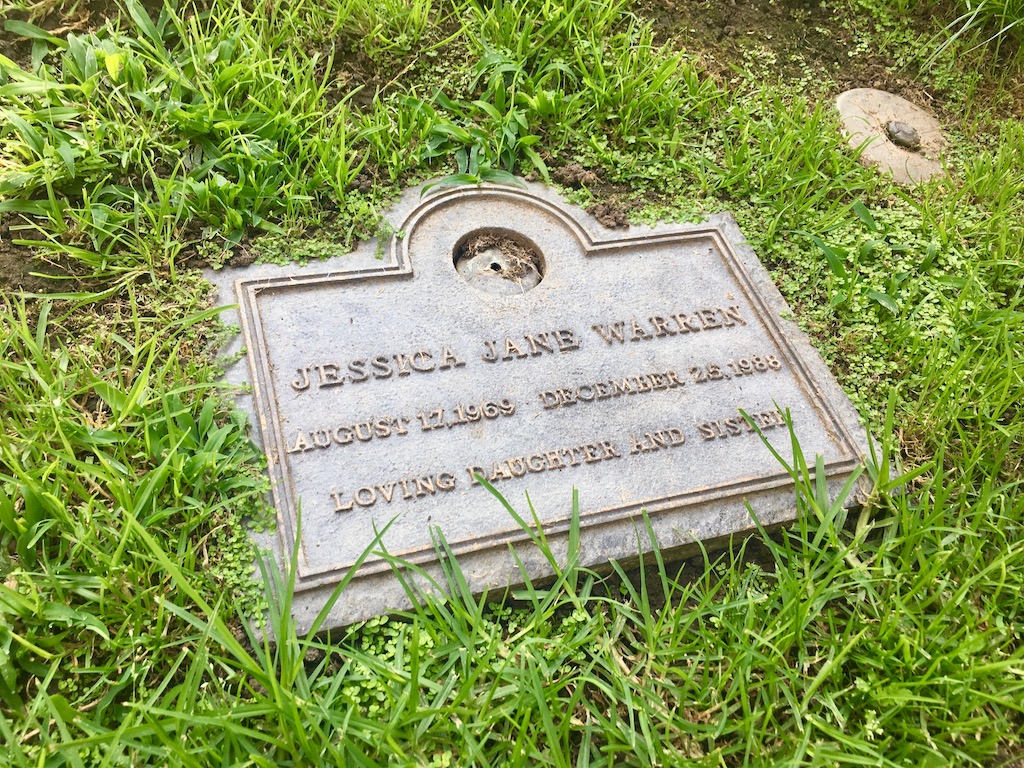
Jessica’s headstone at Pacific View Memorial Park in Corona del Mar. Photo by Greg Hardesty/Behind the Badge
THE SUICIDE
Dawn Hammond and Jessica Warren are buried near each other at Pacific View Memorial Park in Corona del Mar.
Jessica’s cremated remains are located under a headstone near a planter in the Lagunita Court Garden, where visitors can take in million-dollar views of Newport Beach and beyond.
Dawn was cremated and her remains were scattered at sea, but her family memorialized her with a metal plate on a cenotaph. Dawn’s plate is on a pillar under a covered walkway located about 15 feet from Jessica’s headstone, which is surrounded by grass.
On the day of his suicide, Tom went golfing with a friend at the Costa Mesa Country Club.
Before he did, he helped set up a lemonade stand on a corner for his son, Logan, 9 at the time.
“He was in a great mood,” recalls Carrie.
But it had been a rough several months following the suicide of Ken Pate.
Pate’s death had devastated Tom, Carrie says. Tom was not able to counsel Ken personally as a police psychologist after he retired because the two had worked together at the WPD.
Tom was distraught about not getting the chance to try to help Ken, Carrie says.
In the months before his suicide, Tom became moody and depressed, Carrie says.
He began taking medication for anxiety and depression. He agreed to go to Alcoholics Anonymous, Carrie says, after his drinking became an issue.
She recalls Tom getting his 90-day sobriety chip.
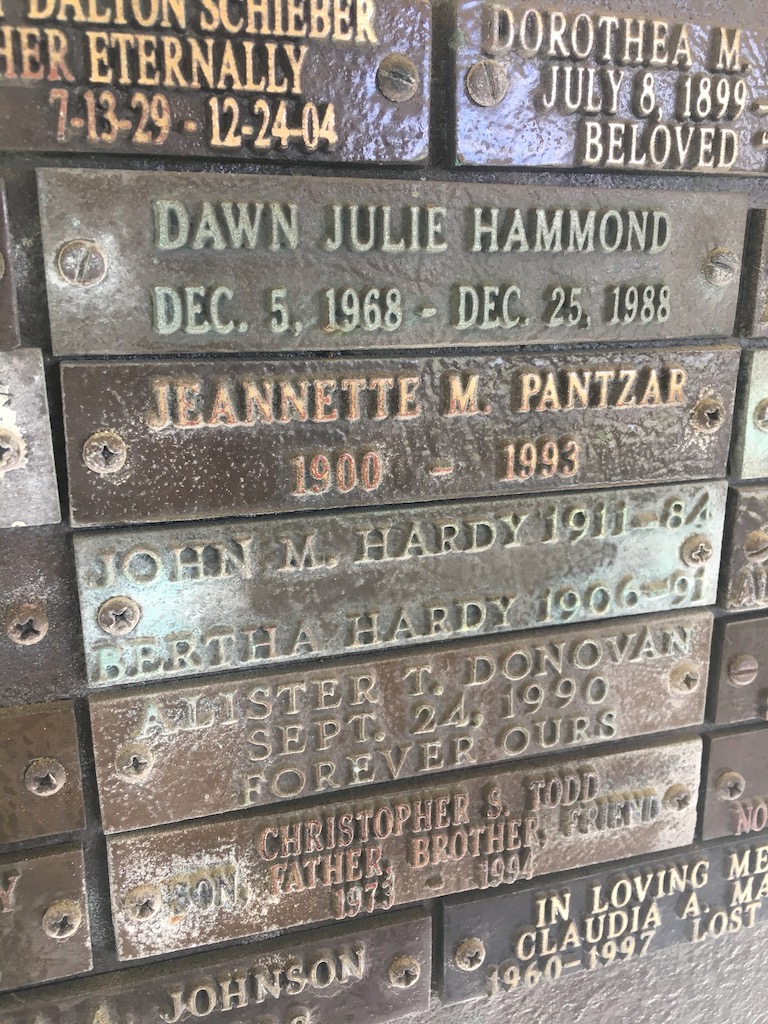
Dawn’s metal plate on a cenotaph at Pacific View Memorial Park in Corona del Mar. Photo by Greg Hardesty/Behind the Badge
Then he started to drink now and then, but only when he was around his wife.
Or so Carrie thought.
When Tom was out playing golf that day, Carrie found a bottle of vodka hidden in the garage.
“When he got home, I blew up at him, yelling at him for lying to me,” Carrie says. “During our argument, I went upstairs to get my daughter (Galina, then 4) out of the bath.”
That was the last time Carrie ever saw Tom.
Logan had heard his parents fighting and saw that his father was about to leave the house.
Carrie says he begged his dad to let him go with him, but Tom said no – that he would be right back.
He never returned.
Carrie is surprised Tom left that night.
“Whenever we had an argument,” she says, “no one ever left. We just worked it out.”
Carrie and Logan tried calling Tom, but found out he had left his cell phone on the counter.
It was a sleepless night for Carrie.
“I must have looked out the window five times that night, looking for his truck in the driveway,” she says.
In the morning, Carrie went onto her computer and looked up a credit card she and Tom shared to see if he had checked into a hotel or withdrawn money from an ATM.
Nothing.
She had a birthday party to go to at a skate park that day for her neighbor’s son’s birthday. She went there with Logan and Galina, figuring she would see Tom when they got home, and the two would talk things out.
During the birthday party, she was surprised to see Cord and Dan, and another close friend of Tom, appear.
But something was very wrong.
They weren’t smiling.
“Tom killed himself,” Cord told Carrie.
“I remember her screams,” Cord recalls. “I remember the sound she made when she fell on the concrete.”
Sitting in his office recently, Cord got choked up when recounting the suicide of one of his best friends.
“It was a horrible 24 hours,” he says of Sunday, Feb. 17, 2013. “It was miserable. But I’m glad I told Carrie. I didn’t want her to hear it over text or something.”
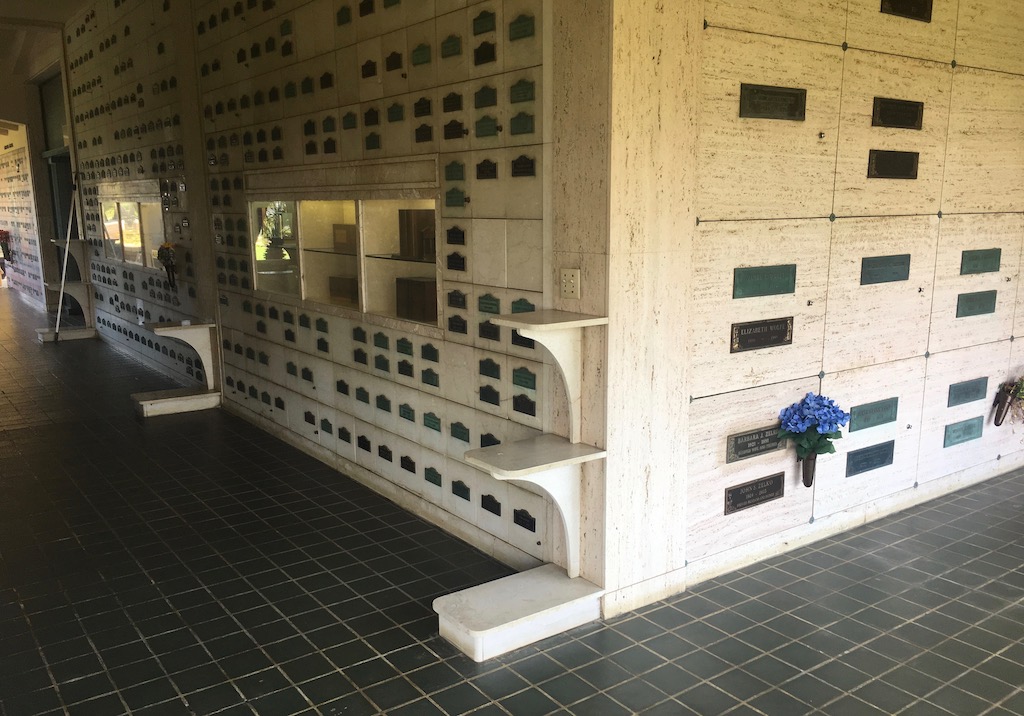
Tom Richard shot himself in the head while sitting against this crypt at Pacific View Memorial Park. His slumped-over body was found near where the blue flowers are. Photo by Greg Hardesty/Behind the Badge
***
After Tom had left his house around 6 p.m. the night of Feb. 16, 2013 after getting into the argument with Carrie, he drove his truck straight to Pacific View Memorial Park, based on surveillance videos.
He drove up a bluff and parked his truck near the Lagunita Court Garden.
Obviously, he had been there before. But he apparently had never told anyone about those visits.
A maintenance worker found Tom the next day.
Tom had walked about 50 yards past the area where Jessica and Dawn are memorialized.
He sat against a crypt facing an area known as Palm Court, and shot himself on the right side of his head.
Scattered around Tom’s body were several index cards – suicide notes.
Inside his truck, in the console, was his life insurance policy – a sign he probably had been planning to kill himself.
Months later, toxicological tests would show that Tom had been drinking that night. His postmortem blood alcohol level was .08 percent – the minimum for being considered legally impaired in the U.S.
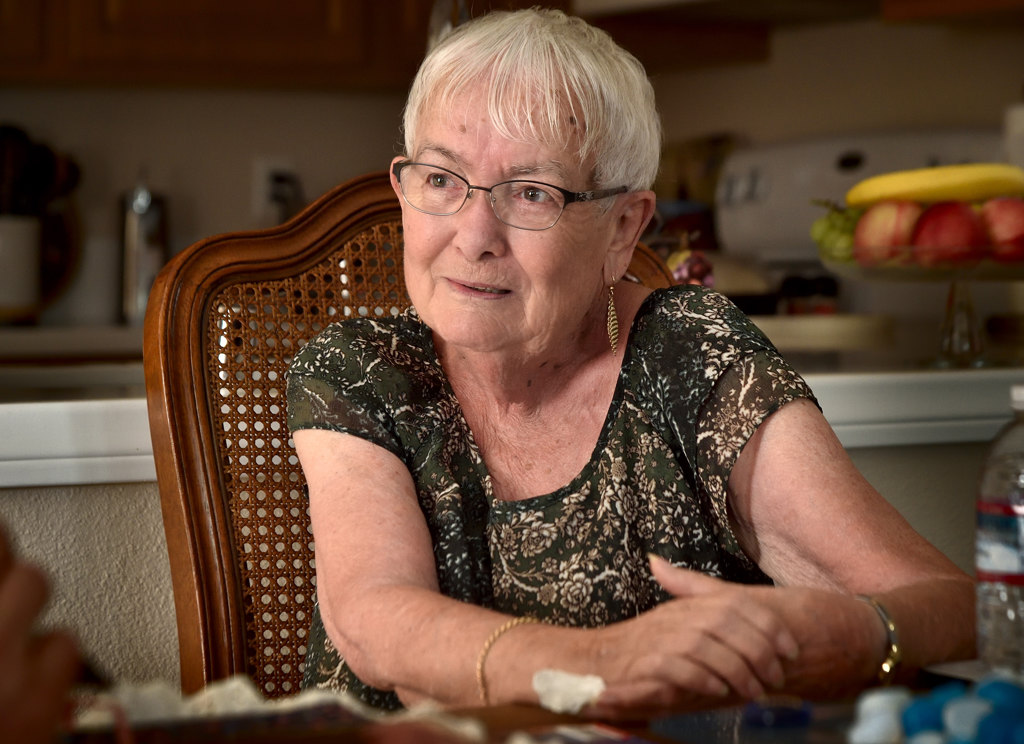
Janet Hammond, 75, of Costa Mesa, talks about her late daughter, Dawn, and Officer Tom Richard. “It was like Dawn died all over again,” Janet says of his Tom’s suicide.
Photo by Steven Georges/Behind the Badge
THE MOTHER
Janet Hammond, 75, thumbs through a scrapbook in her Costa Mesa condo. It’s filled with photos of Dawn and other loved ones.
“I tear up every time I look at it,” Janet says.
A soothing breeze is coming through her open garage door into the dining room, where she sits.
Janet’s ex-husband recently died. Her oldest son, David, 56, is married with two children, Zac and Alexis. Zac is in the Navy. Her other son, Stephen, 54, also has two daughters, Olivia and Charlotte. They live in South Carolina.
Although it’s been more than three decades since Dawn died, the profound sadness of a mother who lost her child remains.
“Dawn loved to swim,” recalls Janet, who is from Coventry, England – famous for Lady Godiva and Jaguar cars. “She was the typical daughter of parents with the means to spoil her. She did ballet, ice skating – she even played soccer. She did it all.”
Janet flew back from England to Orange County on Dec. 26, 1988 after her ex-husband called and said Dawn had been in a bad accident.
Her parents, Jim and Olive, accompanied her.
“Dawn would have been 51 this year,” Janet notes.

Janet Hammond of Costa Mesa talks about her daughter, Dawn (far left in this photo). On the right is Jessica Warren and in the center is another close friend from La Quinta High School.
Photo by Steven Georges/Behind the Badge
Jessica’s mother hated Dawn’s car, a VW bug, Janet says.
“She thought the Honda was a safer car.”
Janet and Dawn were extremely close. Her death sent Janet into years of therapy.
“It takes a long time to get to the point to where you think, ‘Well, at least she didn’t have to spend the rest of her days on life support — you know, a vegetable?” Janet says.
“She didn’t suffer. It was quick.”
Janet’s eyes welled up.
“You never get over it.”
At first, Janet was livid at the jury for acquitting Tom of vehicular manslaughter
Over time, she has been able to see the tragedy for what it was:
A terrible accident.
“He was just a kid doing his job,” Janet says of Tom. “You eventually get to the point where you’re just like, ‘Stuff happens.’”
Maybe. But some holes in the heart never mend.
Now retired, Janet was working at the OC Fairgrounds at the Orange County Wine Society, her job for two decades, when a security guard walked up to her shortly after Feb. 17, 2013.
“I’m sorry to hear about your daughter,” he said to Janet.
She was confused.
“What? She’s been gone for 25 years.”
“Well, you know. The police officer just killed himself.”
Janet recalls the shock, and then the anger, that welled up in her when she heard the news.
“I was so angry,” she says. “I’m sorry, but what a waste. Dawn and Jessica died, and then for him to do that to his family. Why didn’t he come and talk to me?
“It was like Dawn died all over again.”
Janet is asked about efforts to get Tom’s name on a police memorial, and the issue of suicides and mental health in law enforcement.
“It’s something that is good to be talked about,” she says.
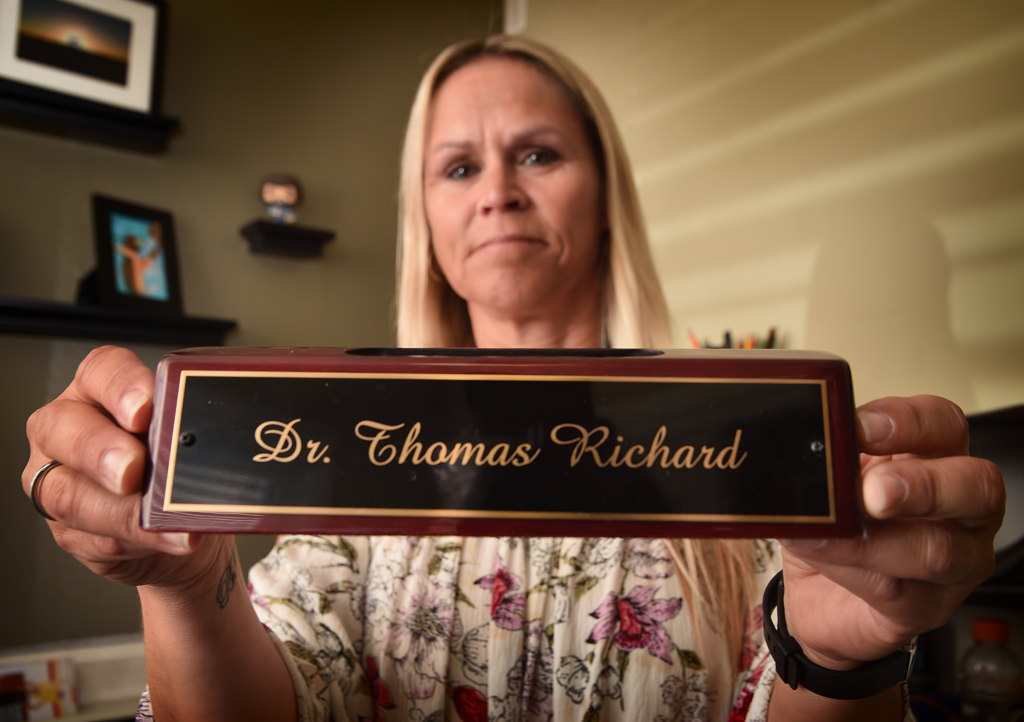
Carrie Richard holds her late husband’s nameplate, which would end up being her last Christmas gift to him. Tom earned a doctorate in psychology and was planning on opening a practice with two other retired peace officers to help cops suffering from PTSD and other mental illnesses.
Photo by Steven Georges/Behind the Badge
THE WIDOW
Carrie’s black lab, Rio, snuggles up to her on the back patio of her five-bedroom home in Costa Mesa – the home she and Tom shared for nearly 15 years.
Her grief over Tom’s suicide still is raw. Talking about Tom brings tears.
“It’s hard,” says Carrie, 49. “ I miss him every day.”
Tom was Carrie’s second husband. She was briefly married to a deputy who encouraged her to become a cop.
A soccer player her entire life, Carrie, who grew up in Newport Beach, currently coaches soccer at Estancia High School and also runs several soccer camps.
She has a boyfriend of four years.
Carrie remains close to Tom’s sons, Conner, 27, and Jake, 25. Between them, they have three kids – Tom’s grandchildren.
Carrie is convinced that if he could, Tom would take back his decision to kill himself.
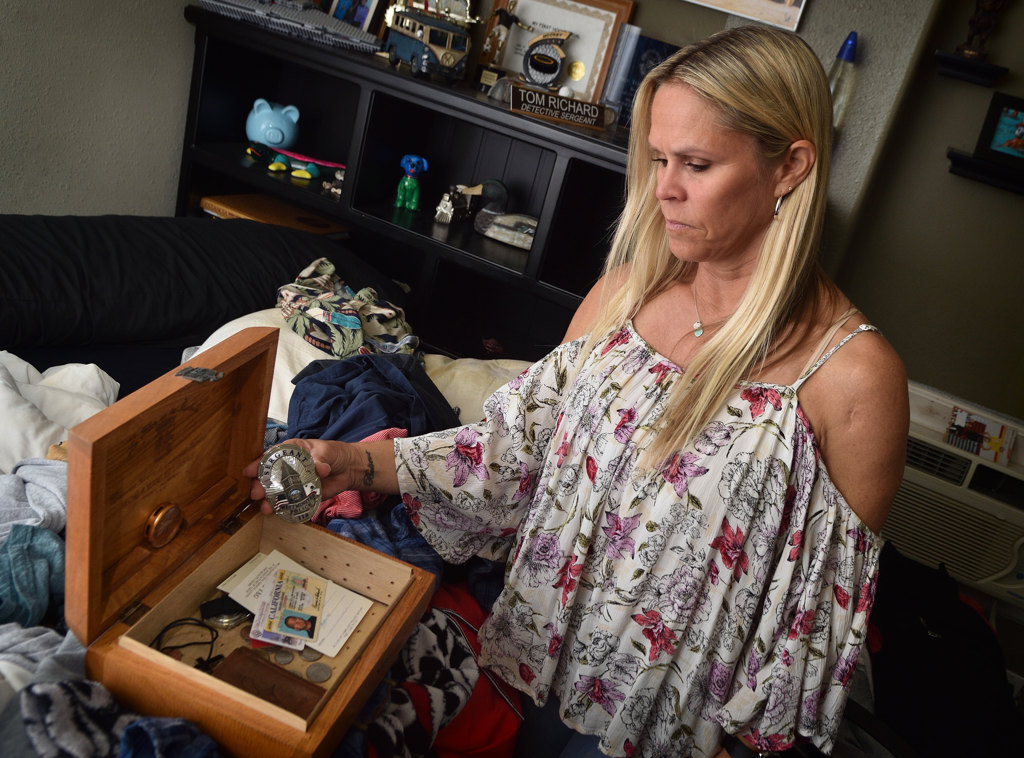
Carrie Richard goes through a box of some of her late husband’s belongings, including his Westminster PD sergeant badge.
Photo by Steven Georges/Behind the Badge
“I would guarantee anything that he would be here for me, for my kids, his grandkids,” she says.
Tom was cremated. Some of his ashes remain at Carrie’s home; others were spread in the Hardy River in Baja California.
She had no idea Tom had been visiting Pacific View Memorial Park. She didn’t even know Dawn and Jessica were buried there. She has never visited the site where Tom killed himself, and even has trouble driving by the cemetery.
In what would be her last Christmas gift to Tom, Carrie had a plaque made for his police psychology practice. It reads:
Dr. Thomas Richard
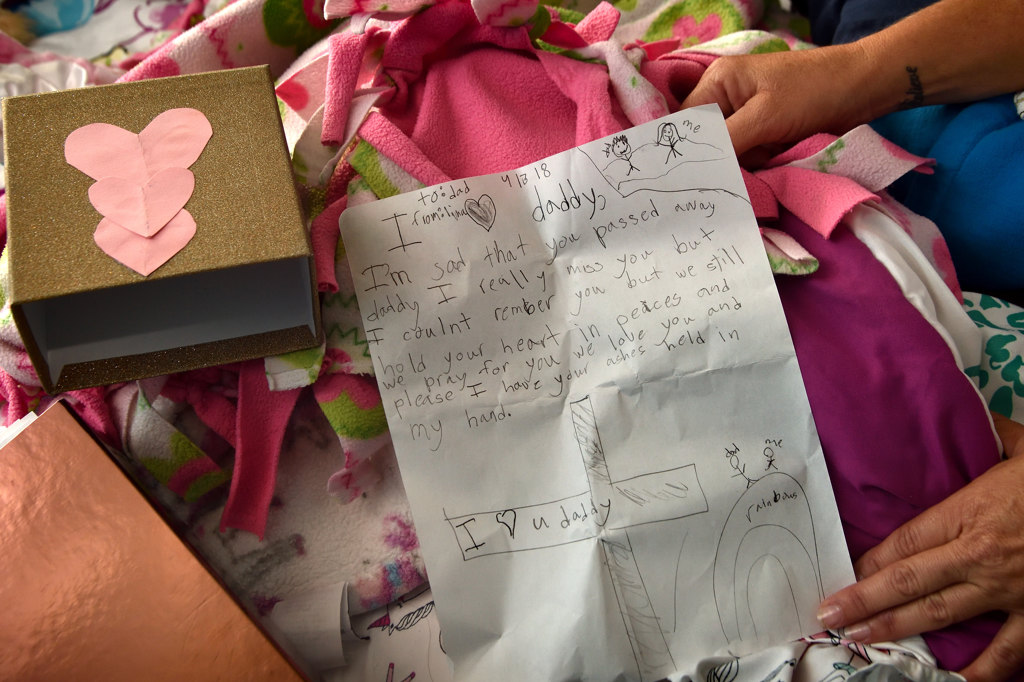
This note was written by Galina Richard. She was 4 when her father killed himself. Photo by Steven Georges/Behind the Badge
She keeps the plaque in Logan’s bedroom.
“It’s my belief that while Tom was trying to help others, he was only bringing up his own trauma over and over again,” Carrie says. “Tom was so excited about helping others that he never dealt with his own issues.”
Carrie believes Tom was planning his suicide.
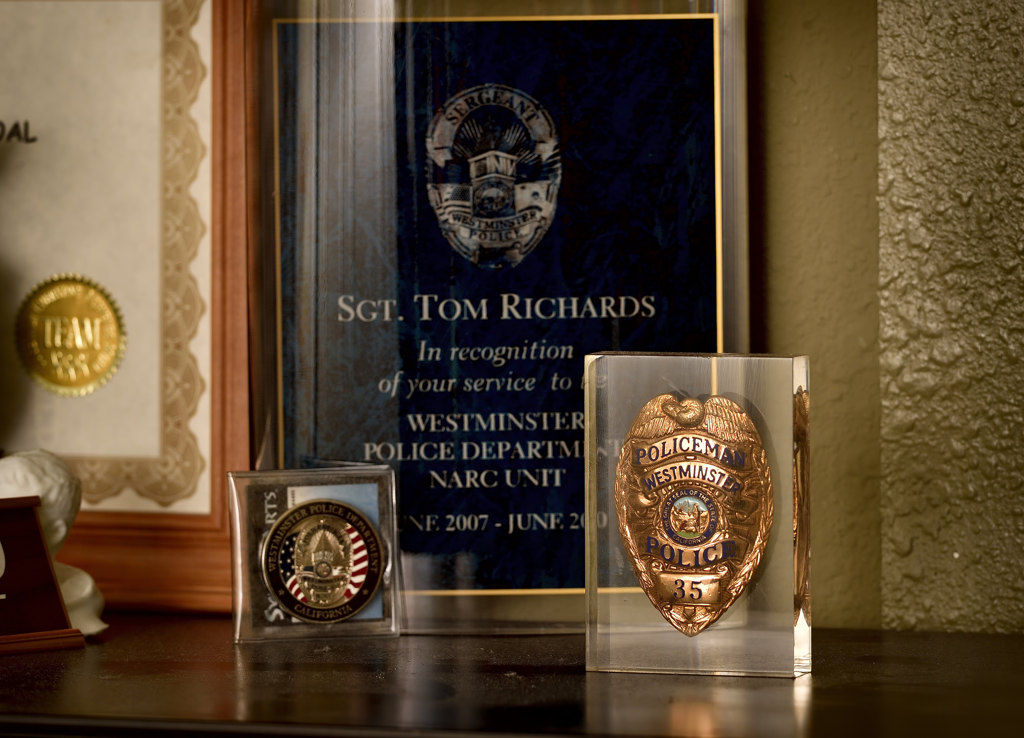
Tom Richard’s badge with some of his other PD memorabilia. His last name is misspelled on the plaque.
Photo by Steven Georges/Behind the Badge
“He was just waiting for the right time,” she says. “He was very spontaneous and would just do stuff on the spur of the moment without any forethought.”
Carrie’s eyes well up.
“I don’t know when the pain is ever going to go away,” she says.
Tom definitely belongs on the WPD’s Peace Officer Memorial, Carrie says.
“I’m upset that he’s not on there. He should definitely be on there. He died for that city. That job took his life. That call took his life.”
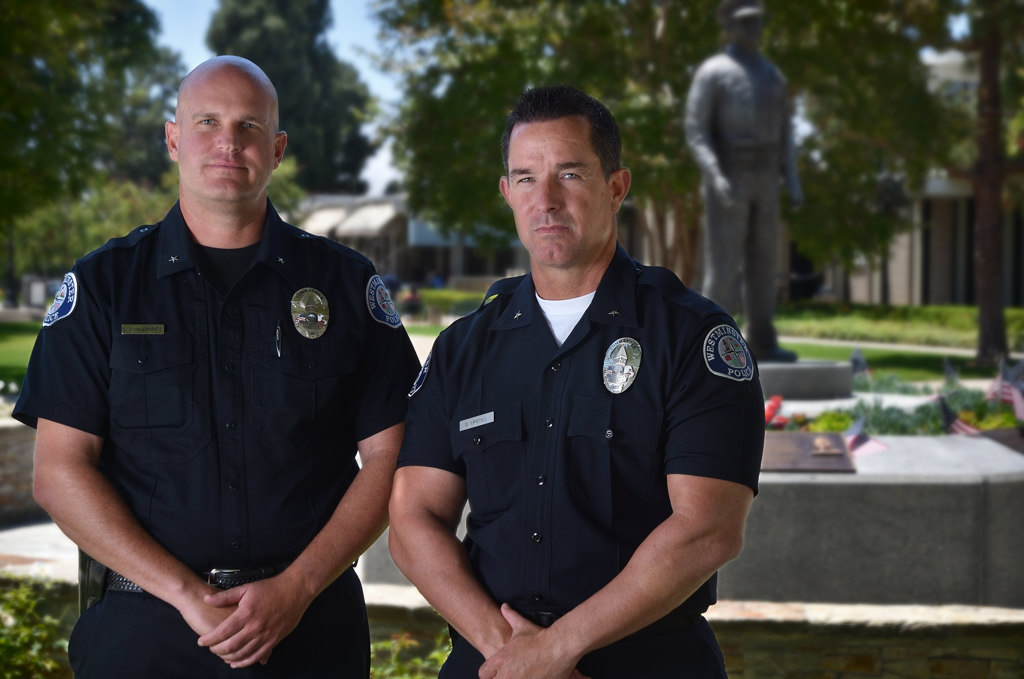
Westminster PD Commanders Cord Vandergrift, left, and Darin Upstill are among several current and retired WPD officers lobbying to get Sgt. Tom Richard’s name added to the Westminster Police Department Memorial.
Photo by Steven Georges/Behind the Badge
THE CAMPAIGN
Currently, there are three names on the Westminster Police Department Memorial.
Lt. Ron Weber’s death on June 6, 2003, from cancer was attributed to exposure to toxic chemicals used in the production of methamphetamine.
Officer Steven Phillips was patrolling on his motorcycle when he was struck and killed on Jan. 29, 2004.
Sgt. Marcus Frank died from a work-related illness on Oct. 10, 2007.
Every year around Memorial Day, the WPD holds a solemn ceremony to honor Weber, Phillips, and Frank.
It’s time, WPD officials and others say, to add Tom’s name to the memorial.

Westminster PD Commanders Cord Vandergrift, left, and Darin Upstill at the Westminster Police Department Memorial.
Photo by Steven Georges/Behind the Badge
Officer Michael Ogawa, president of the WPD’s POA (Police Officer Association) said the board of directors of the POA “will absolutely” honor Tom with a memorial plaque.
“We think it’s a good idea because it puts this once taboo topic (suicide) into the spotlight,” Ogawa says. “With the plaque, citizens of the community, as well as members of our own department, can remember Tom and as well as others who are affected by a life in law enforcement.
“Hopefully, it will help officers come forward and ask for the assistance they need if they are in a situation similar to Tom. Maybe this will give those in law enforcement a sense of comfort to discuss this topic in briefings and elsewhere.
“We as an association think it’s important to bring suicide to the surface. It has to be recognized by the law enforcement community. It has been buried for far too many years.”
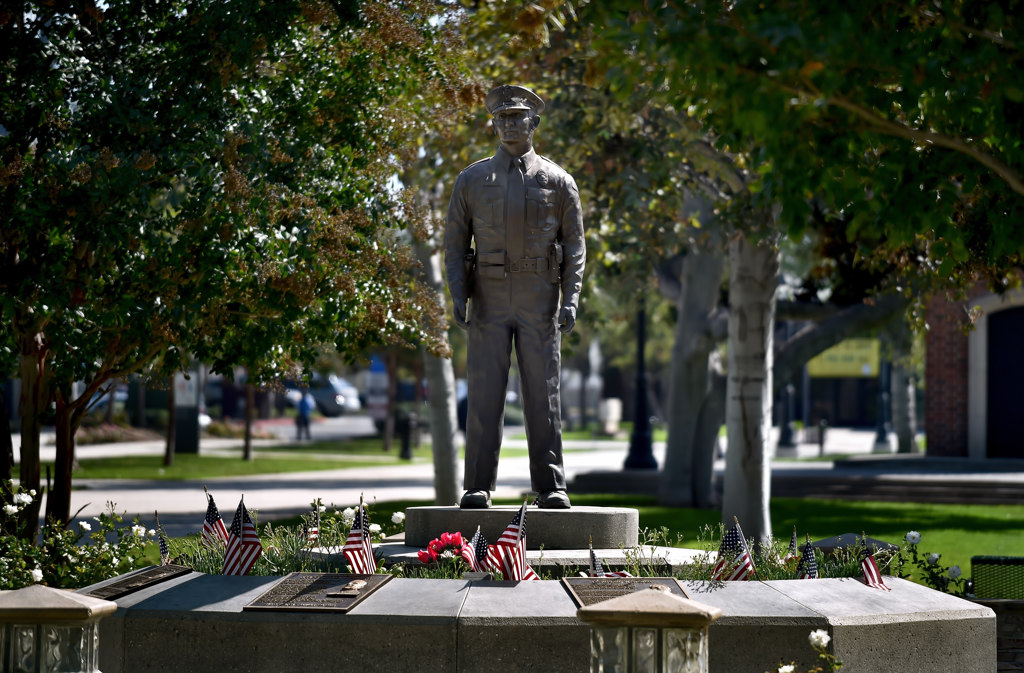
The Westminster Police Department Memorial is located outside PD headquarters.
Photo by Steven Georges/Behind the Badge OC
THE NEED
Heather Williams was one of several counselors employed by Community Service Programs (since renamed Waymakers) who responded to the WPD after Tom’s suicide.
“There was such a heaviness, from officers crying in their patrol cars to ones going into the police department to talk to crisis personnel,” recalls Williams, who co-founded the Orange County Association of Peer Supporters (OCAPS) and is a doctor of psychology and regional peer support coordinator for the Orange County Sheriff’s Department.
“There was a lot of anger, sadness, helplessness, and second-guessing,” Williams recalls.
She never met Tom, but she knew about him from his pioneering work in helping to establish the WPD’s Trauma Support Team.
“I couldn’t wait to meet him,” says Williams. “I considered him a mentor. He was somebody I looked up to.”
Suicide in law enforcement must be de-stigmatized so officers can get the help they need, Williams said.
One encouraging sign: the language about suicide is changing, she noted.
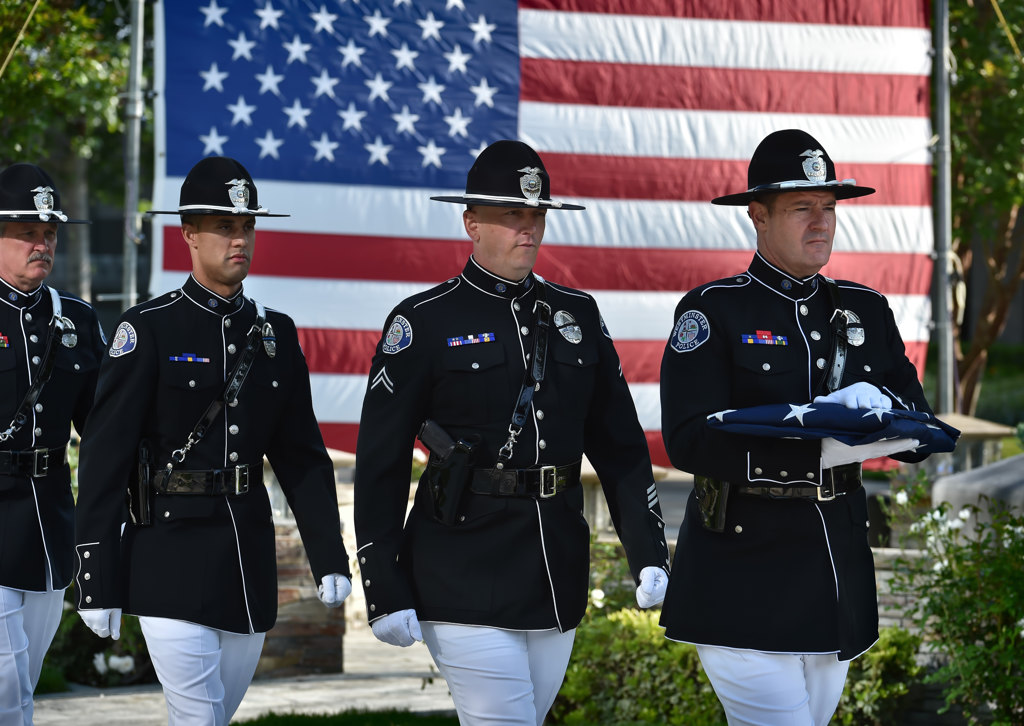
This file photo shows, from left, Westminster PD Honor guards Sgt. Kevin MacCormick, Officer Kees Davis, Cpl. Jeremy Fletcher and Investigator James Delk at an annual ceremony honoring the three WPD fallen officers currently named on the memorial. File photo by Steven Georges/Behind the Badge OC
“To ‘commit’ suicide makes it sound like a crime – like ‘committing’ a crime,” Williams said. “We now say ‘died by suicide.’”
There typically are a multitude of factors that play into a person’s decision to end his or her life – not just PTSD-related issued, Williams said.
“It’s usually an accumulation of things, such as marital issues, depression, substance abuse,” she said. “It’s important for the public to realize this.”
In addition to plans to get Tom’s name on the WPD memorial, Collins is preparing a document to present to a state lawmaker to make the case for Tom to be the first officer who committed suicide to be placed on the California Police Officer Memorial in Sacramento.
“If there were ever a case to be made, this is a very compelling one,” Dan Schoonmaker says.
Adds Cord Vandergrift: “Our ultimate goal is to raise awareness about police suicide…Tom’s suicide no doubt changed my life 100 percent. Anything I thought was important before I now realize was stupid. Politics in the station? Am I going to get this promotion?
“Those things are so irrelevant compared to me sitting on the couch with my daughter and having a discussion about her day.”
A spokesman for the California Police Officer Memorial could not be reached for comment.
Only line-of-duty deaths are eligible for inclusion on the National Law Enforcement Memorial, and suicide isn’t recognized as a line-of-duty death.
“That said, we recognize the growing concern surrounding suicides by law enforcement officers, and are partnering with other agencies to determine how best to address the issue,” said Robyn Small, a spokesperson for the National Law Enforcement Officers Memorial Fund and the National Law Enforcement Museum.
The National Law Enforcement Officers Memorial Fund, Small said, has a comprehensive officer safety and wellness program known as Destination Zero. The program, in partnership with the Bureau of Justice Administration, acts as a repository for officer safety and wellness programs across the country to help keep our officers both physically and mentally healthy.
THE QUESTION
A few years ago, speaking at the annual ceremony outside WPD headquarters to honor the three fallen officers whose names are on the memorial, Carrie Richard made an impassioned plea for police suicide to be addressed and not silenced away.
“You need to know what Tom did to himself could have been prevented,” Carrie said. “If Tom would have continued getting help with his own PTSD condition, he could possibly still be here.
“There’s nothing strong or courageous about hiding your feelings. We all accepted this job to help serve and protect people, because we care. Well, you can’t help others when you’re not able to help yourself.”
May 1, 2019, would have been Tom and Carrie’s 20th wedding anniversary.

Galina Richard as a baby (center) and with her mother (left), Carrie, and father, Tom. Photo by Steven Georges/Behind the Badge
Speaking in her backyard recently, Carrie recalls their first date at a country western bar. They got married at the lake in Rancho Santa Margarita. They honeymooned in Cabo San Lucas, where they would go on to buy two time shares.
For the first time since Tom’s suicide, Carrie revisited Cabo with her loved ones this summer. They stayed a week.
Carrie also recalls attending Ken Pate’s funeral with Tom in May 2012, and the conversation they had.
“How could he do this?” Carrie asked Tom. “How could he leave his wife and children like this?”
Tom turned to his wife and said:
“I don’t know.”
The National Suicide Prevention Lifeline offers 24/7 support at 1-800-273-8255
 Behind the Badge
Behind the Badge
